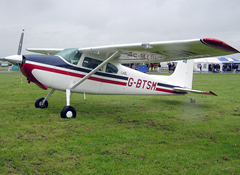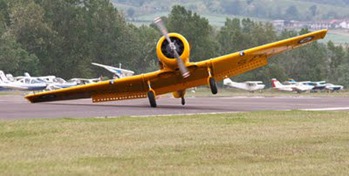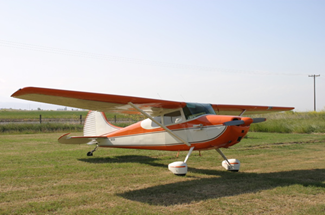There are two types of tailwheel pilots: Those who have ground-looped and those who (eventually) will…
Tailwheel take-off and landing tip: Dance and jab
As we have noted in the past (see: Tips for flying an aircraft with a tailwheel), flying an aircraft with a tailwheel will feel a little different from flying an aircraft without one. However and in a very entertaining post, blogger Alex Hammer has recently recounted his second flying lesson in a taildragger after his flight instructor Dave had given him a very simple piece of advice:
Don’t hold the rudder down too long, just dance on the rudder peddals, jab jab jab.
Alex continues by recalling what happened next:
As I started the roll that began to make sense. Veer right, left pedal jab jab jab right peddal jab, oh boy what a workout, but we’re back on center line. Stick forward. Oh boy. Not what I’m used to rolling on the ground…… Here we go again with the peddals. Jab, Jab, Jab, back on center line. Aha effect. Now I get this whole jab the peddal thing…
Piece of cake, right?!!
Either way, Alex concludes by saying that “these planes require attention, but they are a joy to fly” and that “we should all be so luck to have a guy like Dave introduce us to these fantastic flying machines.” We could not have summed it up better!
Tips for flying an aircraft with a tailwheel
 Flying an aircraft with a tailwheel will feel a little different from flying an aircraft without one and there are some important tips to keep in mind in order to stay safe. Hence and for any pilot who is thinking of flying an aircraft with a tailwheel, Brian (the pilot/blogger behind Brian’s Flying Blog) has recently posted an extensive entry about obtaining a tailwheel endorsement and the differences between flying an aircraft with or without one.
Flying an aircraft with a tailwheel will feel a little different from flying an aircraft without one and there are some important tips to keep in mind in order to stay safe. Hence and for any pilot who is thinking of flying an aircraft with a tailwheel, Brian (the pilot/blogger behind Brian’s Flying Blog) has recently posted an extensive entry about obtaining a tailwheel endorsement and the differences between flying an aircraft with or without one.
Brian begins his post by pointing out that the tailwheel is negatively stable when its on the ground. Thus, when a pilot tries to slow down an aircraft with a tailwheel, the plane will want to flip around because the center of gravity is behind the main wheels. In addition, pilots will also notice that the controls feel a little different due to the distance between the main wheels and the steerable tailwheel. Hence, response time will be delayed and pilots must be careful not to change the steering to much after its already to late.
Brian then proceeds to go into some detail and provides useful tips about taxi operations, takeoffs, 3-point landings and wheel landings for pilots who are flying an aircraft with a tailwheel plus he lists several books and websites with further information. Hence, Brian’s post is well worth reading by any pilot who might consider flying an aircraft with a tailwheel.

